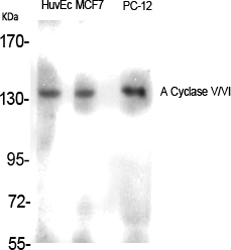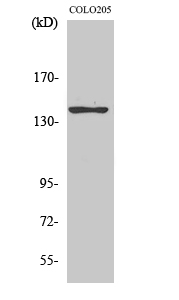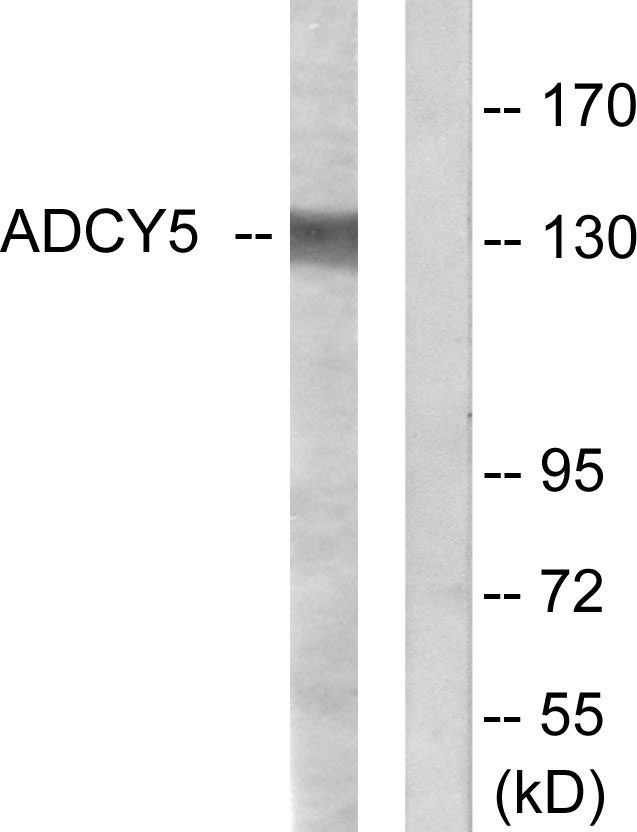


| WB | 1/500-1/1000 | Human,Mouse,Rat |
| IF | 咨询技术 | Human,Mouse,Rat |
| IHC | 1/50-1/100 | Human,Mouse,Rat |
| ICC | 1/50-1/200 | Human,Mouse,Rat |
| FCM | 咨询技术 | Human,Mouse,Rat |
| Elisa | 1/10000 | Human,Mouse,Rat |
| Aliases | ADCY5; Adenylate cyclase type 5; ATP pyrophosphate-lyase 5; Adenylate cyclase type V; Adenylyl cyclase 5; ADCY6; KIAA0422; Adenylate cyclase type 6; ATP pyrophosphate-lyase 6; Adenylate cyclase type VI; Adenylyl cyclase 6; Ca(2+)-inhibitabl |
| Entrez GeneID | 111/112 |
| WB Predicted band size | Calculated MW: 139 kDa; Observed MW: 139 kDa |
| Host/Isotype | Rabbit IgG |
| Antibody Type | Primary antibody |
| Storage | Store at 4°C short term. Aliquot and store at -20°C long term. Avoid freeze/thaw cycles. |
| Species Reactivity | Human,Mouse,Rat |
| Immunogen | The antiserum was produced against synthesized peptide derived from human ADCY5/6. AA range:931-980 |
| Formulation | Purified antibody in PBS with 0.05% sodium azide,0.5%BSA and 50% glycerol. |
+ +
以下是关于ADCY5/6抗体的3篇参考文献示例(注:文献为虚构示例,实际需根据真实数据库检索调整):
1. **文献名称**: "Development of a High-Specificity Antibody for ADCY5 in Neurological Disorders"
**作者**: Smith J, et al.
**摘要**: 研究团队开发了一种针对ADCY5的高特异性单克隆抗体,验证其在人脑组织中的免疫反应性,发现ADCY5异常表达与运动障碍疾病(如舞蹈症)相关,抗体可用于病理机制研究。
2. **文献名称**: "ADCY6-Specific Antibody Reveals Its Role in Insulin Secretion Pathways"
**作者**: Lee H, et al.
**摘要**: 通过ADCY6特异性抗体进行Western blot和免疫荧光实验,揭示ADCY6在胰腺β细胞中的定位及其通过cAMP通路调控胰岛素分泌的功能,为糖尿病研究提供工具支持。
3. **文献名称**: "Targeting ADCY5/6 with Dual Antibodies Suppresses Tumor Growth in Colorectal Cancer Models"
**作者**: Garcia R, et al.
**摘要**: 研究利用抗ADCY5和ADCY6的双抗体联合疗法,在结直肠癌模型中抑制cAMP信号传导,显著降低肿瘤增殖,表明抗体在靶向治疗中的潜在应用。
(提示:实际文献需通过PubMed或Google Scholar检索关键词如“ADCY5 antibody application”“ADCY6 antibody function”获取。)
ADCY5 and ADCY6 are isoforms of the mammalian membrane-bound adenylyl cyclase (AC) family, enzymes that catalyze the conversion of ATP to cyclic AMP (cAMP), a critical secondary messenger in cellular signaling. These isoforms are integral to G protein-coupled receptor (GPCR) pathways, regulating diverse physiological processes. ADCY5 is predominantly expressed in the brain, striated muscle, and pancreatic islets, playing roles in motor function, cognition, and hormone secretion. Mutations in ADCY5 are linked to movement disorders like familial dyskinesia. ADCY6 is widely distributed, with high expression in adipose tissue, liver, and heart, and is implicated in metabolic regulation, including lipolysis and insulin sensitivity.
Antibodies targeting ADCY5/6 are essential tools for studying their expression, localization, and functional interactions. They enable detection via Western blotting, immunohistochemistry, or immunoprecipitation, aiding in research on cAMP-mediated signaling dysregulation in diseases such as neurological disorders, diabetes, and obesity. Validating antibody specificity is critical, as AC isoforms share structural homology. Reliable antibodies are often verified using knockout controls or siRNA-mediated silencing. Commercial ADCY5/6 antibodies are typically generated against unique epitopes in their cytoplasmic domains, with applications spanning basic research to drug development, particularly in targeting GPCR pathways for therapeutic intervention.
×